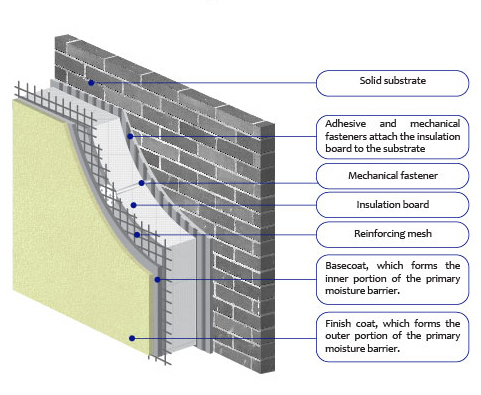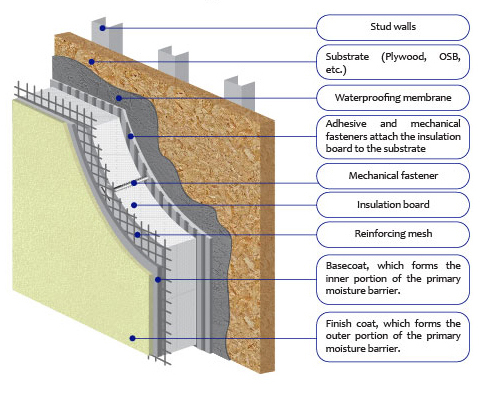Understanding Exterior Insulation Finishing Systems (EIFS) / External Thermal Insulation Composite Systems (ETICS)
Exterior Insulation Finishing Systems (EIFS) and External Thermal Insulation Composite Systems (ETICS) are cutting-edge construction technologies that have transformed the building industry. These thermal insulation systems provide energy-efficient, cost-effective, and sustainable solutions that cater to various building requirements. Terraco explores the ins and outs of EIFS and ETICS, emphasizing their advantages and applications in contemporary construction projects.
EIFS and ETICS are non-load bearing, multi-layered exterior wall systems that integrate insulation, water-resistive barriers, and visually appealing decorative finishes. Both systems are versatile and energy-efficient, making them ideal for new constructions, renovations, and building retrofits. Despite having slight differences in insulation materials and attachment methods, EIFS and ETICS offer similar benefits and are often used interchangeably in the industry.
These systems comprise an insulation board, such as Expanded Polystyrene (EPS), Mineral Wool (MW), or Graphite-enhanced EPS (G-EPS), which is secured to the substrate. A base coat reinforced with mesh is then applied, followed by a decorative finish coat. This multi-layered approach ensures exceptional thermal insulation, reducing energy consumption and contributing to significant savings on heating and cooling costs.
Incorporating EIFS or ETICS into your building design offers numerous advantages:
Sectional view of typical EIFS / ETICS facade insulation on a solid wall

Sectional view of typical EIFS / ETICS on a wood substrate

It is essential to distinguish between EIFS / ETICS systems and traditional stucco, as they differ in composition, performance, and application:
By choosing EIFS and ETICS solutions, you can create innovative, eco-friendly, and cost-effective building designs that meet the demands of today’s construction industry. These systems not only enhance the visual appeal of your building but also contribute to long-term energy savings and sustainability.
Embracing the Future of Building Insulation with EIFS and ETICS
As the construction industry continues to evolve, the adoption of EIFS and ETICS for thermal insulation is on the rise. These systems address the pressing need for energy-efficient and environmentally responsible building solutions, while offering unparalleled design flexibility and cost benefits. By embracing EIFS and ETICS technologies, architects, consultants, and contractors can create cutting-edge, high-performance buildings that meet the needs of today and the future.
EIFS and ETICS are designed to function as complete systems, with each component playing a crucial role in the overall performance. To function properly, EIFS / ETICS needs to be architecturally designed and installed as a system by trained applicators. An EIFS / ETICS system consists of the following components:
Terraco launched its EIFS / ETICS systems in Turkey and Korea in the 1980s, later expanding to Russia, China, and the Middle East during the 1990s. Today, Terraco offers multiple systems such as EIFS Alpha and EIFS Perma, which differ in the type of insulation materials used. Terraco also provides a system for insulated concrete form (ICF) known as ICF Zenith.
The development of EIFS / ETICS can be traced back to the 1950s in Europe. Two major breakthroughs occurred in 1952: the first patent for expanded polystyrene (EPS) insulation board, and the development of the first synthetic plaster using water-based binders. The combination of EPS and synthetic resin materials began in the late 1950s. As the technology evolved, it provided a solution for insulating older masonry structures and enhancing their appearance in the European market.
By the late 1960s, EIFS / ETICS technology had been transferred to the United States, where its application on stud-and-sheathing framing was developed. During the oil crisis of the early to mid-1970s, EIFS gained popularity in the United States as a go-to solution for energy-conscious builders and buyers. By 1980, EIFS accounted for 0.5% of the residential housing market in the United States.
In the 1990s, the EIFS / ETICS industry faced challenges in the United States due to moisture damage caused by water leakage in some EIFS-clad homes. The water ingress was attributed to poor construction detailing and installation practices. Building codes were introduced to mandate the use of drainage on wood-frame buildings and additional on-site inspections. By the turn of the century, governments in Europe introduced energy rating systems for buildings, supporting rapid growth in EIFS adoption.
Today, the EIFS / ETICS industry is focused on formulating fire-resistant Exterior Insulation Finishing Systems by incorporating fire retardant materials and/or fire breaks in the system, an area where Terraco has been actively engaged for some time.
In summary, EIFS and ETICS have come a long way since their inception, and the construction industry has embraced these systems for their ability to provide energy-efficient, aesthetically appealing, and cost-effective solutions. Terraco continues to be a leader in this field, developing innovative and high-performance thermal insulation systems for a sustainable future.
Terraco has developed facade insulation systems, including EIFS and ICF, utilizing various insulation materials or boards to address diverse climatic conditions and building requirements.
EPS (Expanded Polystyrene) is an affordable and widely used insulation material, while Graphite-enhanced (G-EPS) offers 10% greater thermal efficiency, making it ideal for renovation projects. Learn more about EPS insulation here.
MW (Mineral Wool) is a popular thermal insulation system often used when enhanced breathability or fire resistance is required, such as in moisture-prone or older buildings. The Perma system uses highly vapor-permeable decorative renders like Terracoat Sil or Terol for a breathable finish. Discover more about MW insulation here.
ICF (Insulated Concrete Form) is a versatile construction system for both residential and commercial buildings. Constructed using expanded polystyrene ‘blocks’ (ICF), this method provides insulation for both exterior and interior walls. These walls are finished with basecoats, reinforced with mesh, and various decorative finishes. Learn more about ICF insulation here.
By incorporating Terraco’s energy-efficient insulation solutions, architects, consultants, and contractors can create structures that provide numerous benefits:
Whether you’re renovating an existing building or constructing a new one, Terraco EIFS and thermal insulation systems provide the ideal combination of cost-effectiveness, energy efficiency, and environmental sustainability.
Don’t hesitate to contact us for more information and personalized guidance on selecting the right insulation solution for your project.